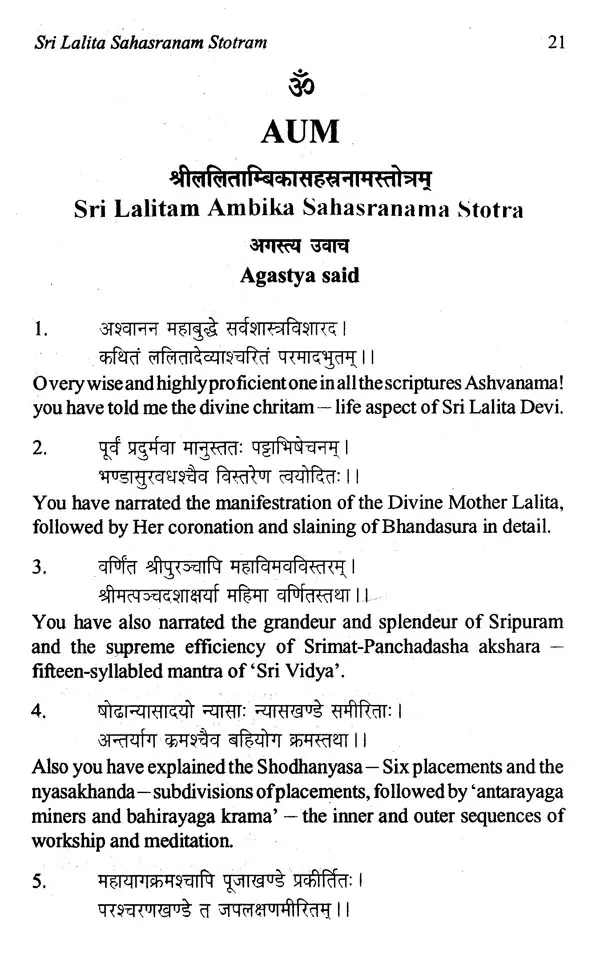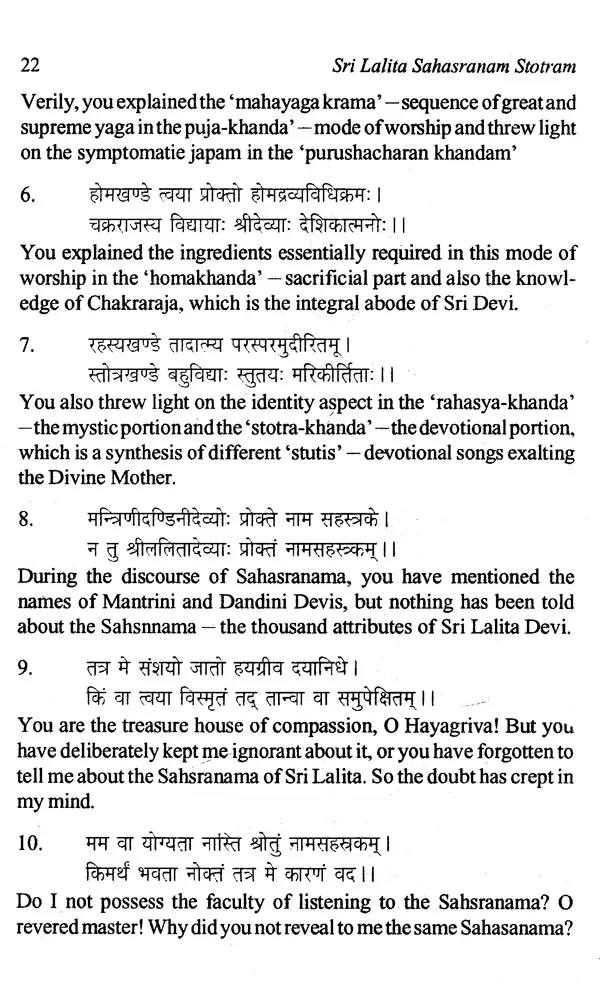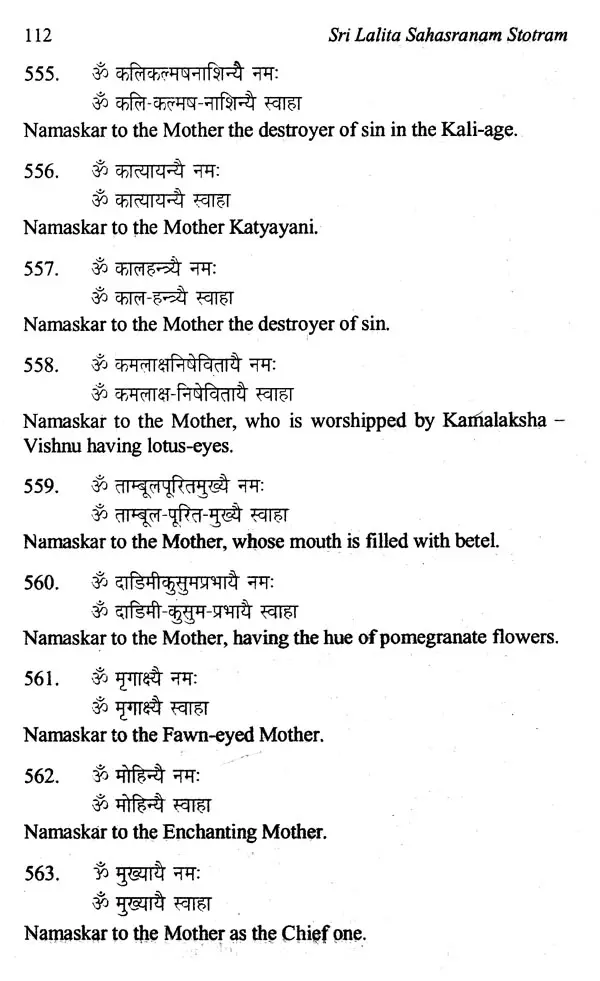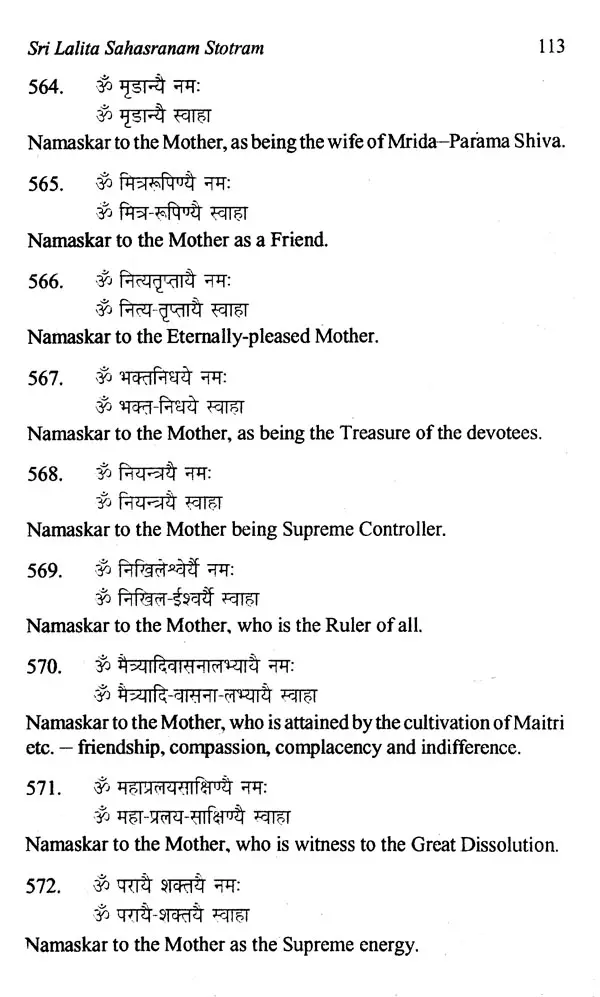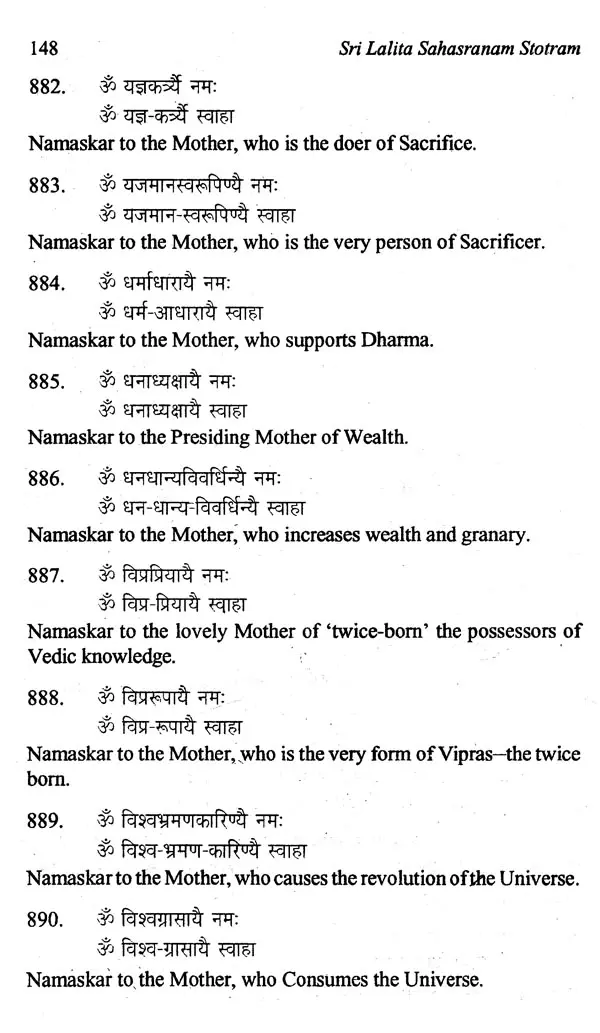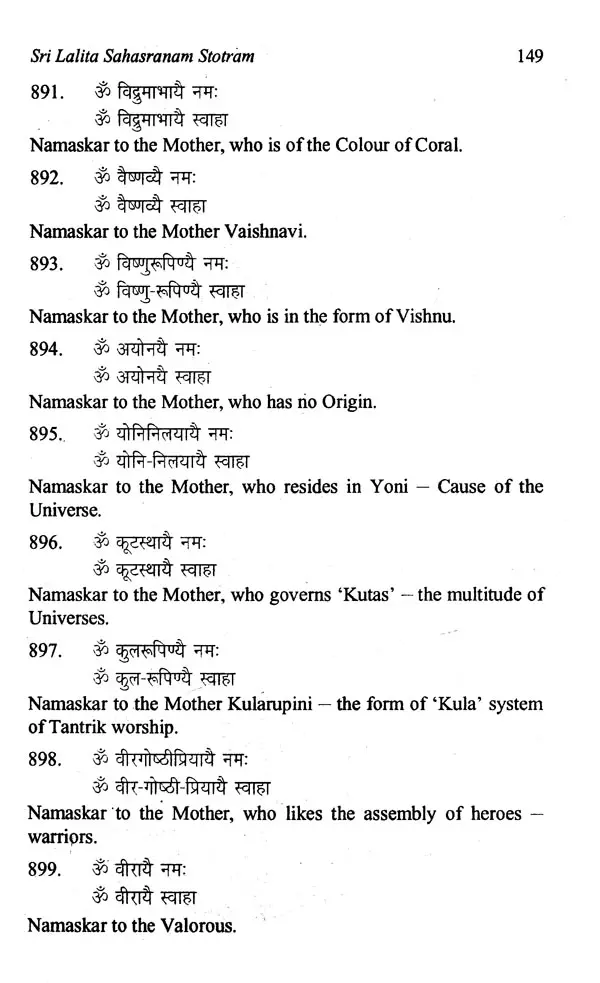
श्रीललितासहस्त्रनामस्तोत्रम् - The Lalita Sahasranama Stotram with English Translation and Annotations (An old and Rare Book)
Book Specification
| Item Code: | UAG169 |
| Author: | C. L. Raina |
| Publisher: | Sharada Publishing House, Delhi |
| Language: | Sanskrit Text with English Translation |
| Edition: | 2000 |
| ISBN: | 8185616280 |
| Pages: | 175 |
| Cover: | HARDCOVER |
| Other Details | 9.00 X 6.00 inch |
| Weight | 300 gm |
Book Description
A nice exposition of the devotional philosophy is found in the `Sri Lalitasahsranama Stotram'. The Supreme Mother Lalita is adored with the thousand divine Names, Conveying a 'journey of Consciousness' from Sri Mata to 'Sri Lalitambika'. This is a highly occult Shakta Scripture and forms a section, of the 'Brahmanda Purana'; and is regarded as the most sacred text by the followers of `Sri Vidya' cult of the Shakta tradition. Being highly mystic in Svarupa' - primal nature, its grand and subtle 'mantra' is imparted to the initiated only by the Guru. The `bijaksara' is the Panchadashaksari mantra' with fifteen syllabled mantra.
This Sahsranama' is a systemised composition of the `Purvabhaga', 'Nyasa', Sahsranama stotra', `Uttarnyasa' and `Uttarbhaga' or prologue, placement of the deities, thousand divine names, post placement ofthe deities and epilogue. The Purvabhaga ' starts with a humble submission from Agastya to the Ashvanana the Lord incarnatae, for the revelation of the manifestation of the Mother-creatrix when she commissioned herself to kill Thandasura' Sage Agastya was very particular to know the description of `Sripuram' and the glory of the `Panchadashakshari mantra'.The sage was also eager to know the mystry of Chakraraj a vidya' of 'Sri Devi', and other allied system of `Homa' and `Homadravya' -Sacrifice and its ingredients.
In this sacred search for 'Truth', 'Sri Hayagriva' cautions the sage to have full devotion and concentration, on his words glorifying the Sahsranama'. Certain injunctions were also incorporated by Sri Hayagriva Himself about imparting its sacred knowledge to a Shatha' - deceitful, Dusta-cunning and `Avishvasin' - man without faith. The Sahsranama should be listened to and heard with absolute faith leaving no room for `Avidya-ignorance'. Thakti' and `Kirtan' are the two essentials of realising the Highest Truth of the Mother. The 'Japan' - repetition of the sacred mantra and `Archana' - recitation of the Names, have been t - iipnastsea ana aumorisea. Vagdevivasini ' were bestowed with Grace to listen to the Glory of Sahsranama, as told by Sri Lalita. Herself to them.
The 'Nyasa' starts with Vashni-adi-vag devata' as the Rishis of the Lalitasahsranama. The metre, is Anushtup, Sri Lalita Tripura-Sundari is the Devata. Aim Srimadvagbhava Kuta is the `bijam', Klim madhya kuta is the Shakti, Sauh Shaktikuta is the Kilakam. Bijam is seed, Shakti is power and Kilakam is the 'nail' of the Stotram. `Dhyanam' is of the 'Mula Prakrti' - Primordial nature. 'Nyasa' means to invite and place the Devata in its particular position in the devotees own self. Devata assumes the 'Mantra' form as the scripture says: 'Mantra in the Deva'. The ‘Karanyasa and Anganyasa makes the Devata abide in the hands and the parts of the body. The Devatas abide in the heart, head, skull, eyes and function as `Kavacham' - the armour of the body and makes all the directions safe leading to Thu, Bhuva and Svah' from the origin, where the devotee and deity are knit together through `Mantra'.
After meditating upon the glory of Sri Lalita, who is of the form of Sindura and Aruna', the formal `Puja' is followed with the `gandham, varieties of flowers, dhupam, dipam, amrtmanaivaidhyam and Sarvopcharas'. These are the physical manifestations of the Divine in the form of `Prithvi - the earthly existence with `gandha' - colours; `Akasa' - space with pushpani flowers; Vayu' - wind with `dhupam or incense, Vahni' fire with burning lamp. Amrtam - ambrosia with naivedhyam presents, offering of fruits, cereals and Sarvatmika'-integrated elements. These, physical constituents in the worship of Lalita are in the form of mystic phonomes of 'Lam, Ham, Yam, Ram, Vam and Sam'. The meaning and subtle nature ofthese phonomes are known to the initiated only.
`Lalita abides in the heart', says Brahma to Markandeya in the Devikavacham! Lalita is the divine Mother, whose heart throbs for the life process. Lalita is the 'Mother of Synthesis' as defined in the Lalitopakhyana an appendage to the Brahmanda Purana. Lalita is Durga, who is worshipped by the Shaktas. She is all emotion, whose sweet face represents the `Vagbhava' group ofmantric syllables. She captures the secret heart-beat of delight, with her Eternal smile. She is the golden sight, who comes down into the heart of the devotee smitting the life with Supreme eternity. The secret name lies in her Eternal attributes which reside in six lotuses in the form of `Kundalini' She is not different from the knowledge that brings `Moksha' -liberation to the bonded soul or `Jivatman'.
Higher emotion is the primal cause of existence, known as Thavajna'. Being the Supreme energy, she is meditated upon with the loving adoration. Her abode is the Sri Yantra, when adored as Sri Rajrajeshvari. Her feet are the musical metres and the Vedic-Nirukhta is her Lovely face. The Rigveda is her seat. The Yaju and. Sam are her thighs. Nyaya and Darshan are the two breasts. The Shruti and Smriti are the lips. The poetics is Her Charming tongue. The Vida.nta-and other allied subjects are Her eternal eyes, which guides the Thakta' - devotees through intuition, understanding and insight. Her ecstasy is found in Gayan, Vadan and Nritya' - song, music and dance.
Lalita is always adored by Ishvara, Sadashiva and a host of Devatas. She is the Mother-Creatrix and the very self of "Satcitananda'-truth-consciousness-bliss.
Lalita is the primal source of 'Para, Pashyanti and Madhyama. She is the infinite `Vaikhare, born from the silence of Eternity. This state of existence is Prakasha and Vimarsha. Hera Divine flow is spontaneous. Icha, Kriya and Jnan are Her Manifestatism in the living heart. According to the Shakta school, there is only one Reality, where Transcendental, Absolute, Immutable, Ineffable Lalita is known as Prakasha - Supreme Effulgence, which contains in itself the seed of consciousness. When it vibrates to manifest of itself, a movement or Icha takes place. This deliberation is known as Vimarsha' - reflection. The Kamakala-vilas says that Vimarasha is the reflection of the mirror of Prakasha The Prakasha and Vimarsha are the Shiva and Shakti aspects of Sri Lalita.
She manifests through the `Mula trikuna' known as Sarvasiddhiprada chakra' of Lalitambika. The primary triangle is the eternal flame with the `tejas' of Surya - the solar energy, the `Soma tattva' - lunar effects and `Agni' - physical fire. The triadic of tejas' are Her three eyes representing the Universal incarnation. She is verily the Vidyavati - the physical, Meta-physical and transcendental knowledge of the triadic mysticism of the Shakti cult. Her charm, glory and silence is seen in the Primal `Bindu’ which is being meditated upon as Trikhanda mudra' by the Shodasi worshippers of Sri Lalita. Perception and emotion make Lalita to abide in Sri Chakra where the `Mula-bindu' is Her heart region. A compassion leans to embrace the physical constituents of `Jivatman' to make the life cycle a complete one.
Ever gracious Lalita is visualised in the multiple faces of Universal consciousness. Her ways are mysterious, diverse and ever blooming. She is super brilliance, who upholds the mystery of the emotional play. She is fertile and her Emotion is the cosmic union of Kameshvara and Kameshvari. She is Shiva and Shakti, possessed with the singular supreme love. She is the whole, where every part and particle finds its abode in Her. She is self and beyond that, who is meditated upon as the Swatantrya Shakti', as visualised by Shiva the Supreme teacher of Tandava-nritya ' - the cosmic dance. His dance makes the rhythm of Time in its movement, but Lalita transcends the cosmic whirl of Time and is hid in it like a pearl in the sea. She is the Supreme Sovereign, with the authority of `Chaitanya - consciousness of Being. With her Emotional appearance, she is the fountain head of the nectar of consciousness. Emotion is her primal vibration known as Spanda' - which is the source of all creation. She creates and sustains the world with her Love and then makes the world merge in the Higher ego. Filled with compassion, she is fashioned within the heart by Her intellect. Her presence is felt in the heart-cavern. Yogis meditate upon her to realize the infinite digit of immortality. Her song is auspicious with the tune of universal vibration.

